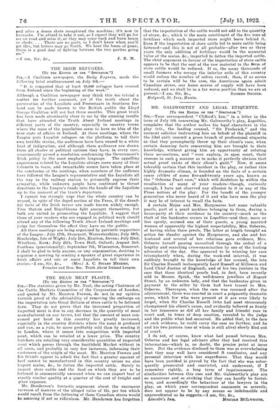MR. GALSWORTHY AND LEGAL ETIQUETTE.
[TO THE EDITOR Or THIS " SPECTATOR."] Sea,—Your correspondent " Clifford's Inn," in a letter in the issue of July 8th concerning Mr. Galsworthy's play, Loyalties, complains that the author makes his legal characters in the play (viz., the leading counsel, " Sir Frederick," and the eminent solicitor instructing him on behalf of the plaintiff in the libel suit) commit a gross breach of professional etiquette in that they peremptorily throw up their client's case, when certain damning facts concerning him are brought to their knowledge, without giving him an opportunity of refuting these accusations, and " even explain, in open court, their reasons in such a manner as to make it perfectly obvious that actual proof exists of their client's gailt." Now, it seems tolerably certain that this incident in the play, or rather this highly dramatic climax, is founded on the facts of a certain cause Mare of some five-and-twenty years ago, known as the " Osborne Pearl case," which will doubtless be within the recollection of many of your readers—though, curiously. enough, I have not observed any allusion to it in any of the Press notices of the play. For the benefit of the younger generation who never heard of it and who have seen the play it may be of interest to recall the facts.
A certain Major and Mrs. Hargreaves lost some valuable pearls, part of a pearl necklace belonging to them, during a house-party at their residence in the country—much as the theft of the banknotes occurs in Loyalties—and they, more or less openly, accused one of their guests, a young married woman of apparently the highest respectability, Mrs. Osborne, of having stolen these jewels. The latter at length brought an action for slander against the Hargreaves, and she and her husband and several of her relations gave evidence, Mrs. Osborne herself passing unscathed through the ordeal of a lengthy and searching cross-examination by one of the leading advocates of the day. She. appeared to be winning her case triumphantly when, during the week-end interval, it was suddenly brought to the knowledge of her counsel, the late Sir Charles Russell (subsequently Lord Russell of Killowen and Lord Chief Justice of England), and of his two juniors in the case that these identical pearls had, in fact, been recently sold to Messrs. Spink, the well-known jewellers of Regent Street, by an unknown lady, and that the banknotes given in payment to the seller by them had been traced to Mrs. Osborne. Thereupon, when the case was resumed after the adjournment, there was enacted in court a poignantly dramatic scene, which few who were present at it are ever likely to forget, when Sir Charles Russell (who had most strenuously championed his client's cause, and evidently believed as firmly in her innocence as did all her family and friends) rose in court and, in tones of deep emotion, revealed to the judge and the public what had occurred. He added that, in the face of such evidence, he could carry the case no further, and he and his two juniors (one of whom is still alive) slowly filed out of court.
I do not, of course, know what had passed between Mrs. Osborne and her legal advisers after they had received this information—which is, no doubt, the precise point at issue here. But the evidence disclosed to them was so overwhelming that they may well have considered it conclusive, and any personal interview with her superfluous. That they would have been justified is proved by the fact that she was subse- quently prosecuted and convicted, and underwent, if I remember rightly, a long term of imprisonment. The similarities between this case and Mr. Galsworthy's play are so numerous and so striking that they can hardly be fortui- tous, and accordingly the behaviour of the lawyers in the play, on which your correspondent comments so severely, does not appear to be by any means so indefensible and unprecedented as he suggests.—I am, Sir, &c.,


































 Previous page
Previous page